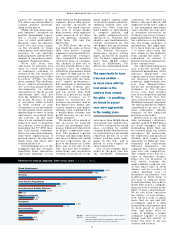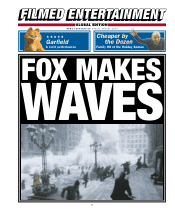Twenty-First Century Fox 2004 Annual Report Download - page 19
Download and view the complete annual report
Please find page 19 of the 2004 Twenty-First Century Fox annual report below. You can navigate through the pages in the report by either clicking on the pages listed below, or by using the keyword search tool below to find specific information within the annual report.
17
Local Markets Stay Tuned For More FOX
Increased efficiency and increased market share characterized yet
another record year for Fox Television Stations, Fox Entertainment
Group’s 35 owned-and-operated broadcast stations in the United States.
The Company’s strategy of owning duopolies – two stations in a single
large market – has led to major improvements in the operations and
results of the stations around the U.S. News Corporation has duopoly
stations in nine of the top 20 markets in the U.S., including the top
three markets of New York, Los Angeles and Chicago.
By the end of fiscal 2004, the integration of the duopoly stations
was virtually complete.
The New York duopoly of WNYW and WWOR made market share
gains against their local competitors. In Los Angeles, KTTV and KCOP
saw ratings success. By the end of the fiscal year, KTTV was producing
the top-rated morning and evening newscasts, as well as winning the
competitive early-fringe and prime-access time slots. After moving to
a more competitive time period, KCOP’s news began beating two of
the other established late newscasts and quadrupled its audience
among the coveted younger demographics. And in Chicago, WFLD
was the number one billing station in the market for the first time in
the station’s history.
Around the rest of the countr y, Fox’s stations excelled not only
in ratings and financial performance, but also in their focus on their
communities. In fiscal 2004, the stations as a group added 57 hours
of news to each week’s programming. The increase in news coverage
to an already strong news slate brought the total local news broad-
casts across the 35 stations to 846 hours each week.
NEWS CORPORATION ANNUAL REPORT 2004
WNYW New York, NY
WWOR New York, NY
KTTV Los Angeles, CA
KCOP Los Angeles, CA
WFLD Chicago, IL
WPWR Chicago, IL
WTXF Philadelphia, PA
KDFW Dallas, TX
KDFI Dallas, TX
WFXT Boston, MA
WTTG Washington DC
WDCA Washington DC
WAGA Atlanta, GA
WJBK Detroit, MI
KRIV Houston, TX
KTXH Houston, TX
KMSP Minneapolis, MN
WFTC Minneapolis, MN
WTVT Tampa Bay, FL
KSAZ Phoenix, AZ
KUTP Phoenix, AZ
WJW Cleveland, OH
KDVR Denver, CO
WRBW Orlando, FL
WOFL Orlando, FL
KTVI St. Louis, MO
WDAF Kansas City, MO
WITI Milwaukee, WI
KSTU Salt Lake City, UT
WBRC Birmingham, AL
WHBQ Memphis, TN
WGHP Greensboro, NC
KTBC Austin, TX
WUTB Baltimore, MD
WOGX Gainesville, FL
FOX TELEVISION STATIONS
TELEVISION
























